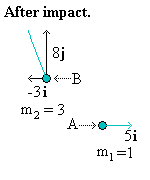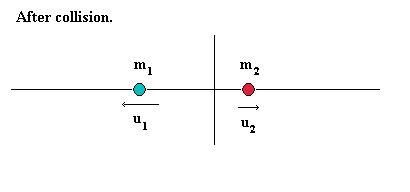Colin James Physics - Physics data.

Last updated: 2nd April 2014.
Collision - elastic - one dimension - calculations and formulae.
Collision - elastic - two dimensions - example with calculations.
Electromagnetism - Fleming's Rules.
Electromagnetism - Maxwell's Equations.
Physical constants - recommended values.
SI prefixes and units.
Elastic collision in 2 dimensions.
Contents of this page.

1. Introduction.
2. Example - start.
3. Example - equations.
4. Example - solution.
5. Example - short cut to solution.
6. Example - line of centres in direction -j instead of j.
1. Introduction.
This page shows an example of two smooth spheres labelled A and B colliding without loss of energy (elastic collision = kinetic energy is conserved).
The masses and initial velocities of both spheres and the line of centres at the moment of impact are given. From these we can find the final velocities of both spheres.
Because the spheres are smooth there is no component of force at right angles to the line of centres on impact. This means that the components of velocity at right angles to the line of impact are the same before and after the collision.
This example uses vectors to define the speed and direction of the spheres. Unit vectors i and j are orthogonal (at right angles). Relating these to Cartesian coordinates, i points in the direction of the positive x axis and j points in the direction of the positive y axis.
On this page I use the vector notation whereby a vector is shown in bold, for example i.
Velocity components before the collision are represented by v and those after the collision by u.
2. Example - start.
Two spheres A and B collide elastically (kinetic energy is conserved).
* -----
Sphere A has mass m1 = 1 and initial velocity (before impact) v1 = (v1xi + v1yj) = 5i + 12j
and final velocity (after impact) u1xi + u1yj

* -----
* -----
Sphere B has mass m2 = 3 and initial velocity (before impact) v2 = (v2xi + v2yj)= -3i + 4j
and final velocity (after impact) u2xi + u2yj

* -----
When they collide the line of centres (the line joining the centre of sphere A and the centre of sphere B) is in the direction j
Problem: calculate the final velocity components of sphere A (u1xi + u1yj) and sphere B (u2xi + u2yj).
3. Example - equations.
Conservation of momentum in the x direction:
m15i + m2(-3)i = m1u1xi + m2u2xi
(1 x 5) + (3 x (-3)) = 1 x u1x + 3 x u2x
5 - 9 = u1x + 3u2x
-4 = u1x + 3u2x
Conservation of momentum in the y direction:
m112j + m24j = m1u1yj + m2u2yj
1 x 12 + 3 x 4 = 1 x u1y + 3 x u2y
12 + 12 = u1y + 3u2y
24 = u1y + 3u2y
24 - 3u2y = u1y
u1y = 24 - 3u2y ----- (1)
Conservation of kinetic energy:
(1/2)m1v12 + (1/2)m2v22 = (1/2)m1u12 + (1/2)m2u22
m1(52 + 122) + m2(32 + 42) = m1u12 + m2u22
1 x (25 + 144) + 3 x (9 + 16) = 1 x (52 + u1y2) + 3 x ((-3)2 + u2y2)
132 + 3 x (52) = (25 + u1y2) + 3 x (9 + u2y2)
169 + 75 = 25 + u1y2 + 27 + 3u2y2
169 + 13 = u1y2 + 3u2y2
182 = u1y2 + 3u2y2 ----- (2)
4. Example - solution.
We have two equations (1) and (2) above in the two unknowns u1y and u2y. To solve the equations we can eliminate one of the unknowns to find the other one and then repeat the process for the other unknown or just put the found value into equation (1) which is easier because (1) is linear whereas (2) is quadratic.
If we square equation (1) to get u1y2 we can put that value in equation (2) and find the value of u2y
u1y = 24 - 3u2y ----- (1)
u1y2 = (24 - 3u2y)(24 - 3u2y)
u1y2 = 24 x 24 - 72u2y - 72u2y + 9u2y2
u1y2 = 576 - 144u2y + 9u2y2
Insert this in equation (2):
182 = 576 - 144u2y + 9u2y2 + 3u2y2
0 = 384 - 144u2y + 12u2y2
12u2y2 - 144u2y + 384 = 0
Divide through by 12:
u2y2 - 12u2y + 32 = 0
Look for the factors of 32 that add up to 12 (8 x 4 =32 -> 8 + 4 = 12), make the factors negative (-8 x -4 =32 -> -8 - 4 = -12) :
(u2y - 8)(u2y - 4) = 0
u2y = 8 or u2y = 4
The solution u2y = 4 corresponds to no collision as this is the component in the direction of the line of centres (the component that will change on impact) but was also 4 before the collision and therefore hasn't changed.
The solution u2y = 8 is the one we are looking for corresponding to the collision.
If we put u2y = 8 in equation (1) we get:
u1y = 24 - 3u2y ----- (1)
u1y = 24 - (3 x 8)
u1y = 24 - 24
u1y = 0
As the components of velocity at right angles to the line of impact are the same before and after the collision:
v1x = u1x = 5
v2x = u2x = -3
* -----
The final velocity components of:
sphere A are (u1xi + u1yj) = (5i + 0j); and
sphere B are (u2xi + u2yj) = (-3i + 8j)


* -----
The initial velocity components of:
sphere A were (v1xi + v1yj) = (5i + 12j); and
sphere B were (v2xi + v2yj) = (-3i + 4j)
We can see that the loss of momentum (mass x velocity) in the y direction by sphere A (1 x 12) = [12] -> 0
has become the increase in the momentum (mass x velocity) in the y direction of sphere B (3 x 4) -> (3 x 8) [3 x (8 - 4) = 3 x 4 = 12].
We can check that kinetic energy has been conserved.
Initial kinetic energy:
(1/2)m1v12 + (1/2)m2v22 =
(1/2)[1 x 132 + (3 x 52)] =
(1/2)[169 + 75] = (1/2)[244] = 122
Final kinetic energy:
(1/2)m1u12 + (1/2)m2u22 =
(1/2)[1 x 52 + (3 x {(-3)2 + 82})] =
(1/2)[25 + (3 x {9 + 64})] = (1/2)[25 + (3 x 73)] = (1/2)[25 + 219] = (1/2)[244] = 122
So as the initial and final kinetic energies are the same, kinetic energy has been conserved.
5. Example - short cut to solution.
We can take a short cut to the solution of this example by using the equations for the general solution of a one dimensional elastic collision.
Because the spheres are smooth there is no force at right angles to the line of impact and therefore the velocities at right angles to the line of impact do not change.
The only forces are along the line of impact (one dimension) and we can treat the changes in velocity of the two dimensionsal collision as one dimensional.
This is what happens in one dimension:
Two particles labelled 1 and 2 collide head on and rebound without loss of energy (elastic collision = kinetic energy is conserved).
Before they collide:
Particle 1 has mass m1 and speed v1
Particle 2 has mass m2 and speed v2

After they collide and rebound:
Particle 1 has mass m1 and speed u1
Particle 2 has mass m2 and speed u2

The equations for u1 and u2 are:
u1 = (2m2v2 + (m1 - m2)v1)/(m1 + m2)
u2 = (2m1v1 + (m2 - m1)v2)/(m1 + m2)
Further information: Collision - elastic - one dimension - calculations and formulae. [Opens in a new window].
In this particular two dimensional example:
u1y = (2m2v2y + (m1 - m2)v1y)/(m1 + m2)
u2y = (2m1v1y + (m2 - m1)v2y)/(m1 + m2)
We can find u1y and u2y for this example by substituting the values shown on this page.
For sphere A: v1y = 12j; m1 = 1
For sphere B: v2y = 4j; m2 = 3
u1y = (2 x 3 x 4j + (1 - 3)12j)/(1 + 3)
u1y = (24j - 24j)/(4)
u1y = 0j ----- [This agrees with the solution found in section 4 above.]
u2y = (2 x 1 x 12j + (3 - 1)4j)/(1 + 3)
u2y = (24j + 8j)/4
u2y = 32j/4
u2y = 8j ----- [This agrees with the solution found in section 4 above.]
6. Example - line of centres in direction -j instead of j
In the above example we chose the line of centres to point in the direction j and then checked conservation of momentum in the y direction (the same direction as j). The line of
centres is defined by two points so it could equally be said to point in the direction of -j.
What happens to the solution if we say that when the spheres collide the line of centres (the line joining the centre of sphere A and the centre of sphere B) is in the direction -j?
We can look at conservation of momentum in the -y direction:
m1(-12)(-j) + m2(-4)(-j) = m1u1(-y)(-j) + m2u2(-y)(-j)
1 x (-12) + 3 x (-4) = 1 x u1(-y) + 3 x u2(-y)
-12 - 12 = u1(-y) + 3u2(-y)
-24 = u1(-y) + 3u2(-y)
-24 - 3u2(-y) = u1(-y)
u1(-y) = -24 - 3u2(-y) ----- (3)
If we square equation (3) to get u1(-y)2 we can put that value in equation (2) and find the value of u2(-y)
u1(-y) = -24 - 3u2(-y) ----- (3)
u1(-y)2 = (-24 - 3u2(-y))(-24 - 3u2(-y))
u1(-y)2 = (-24) x (-24) + 72u2(-y) + 72u2(-y) + 9u2(-y)2
u1(-y)2 = 576 + 144u2(-y) + 9u2(-y)2
Insert this in equation (2) modified to show components in the (-y) direction instead of the y direction:
182 = u1(-y)2 + 3u2(-y)2 ----- (Modified equation 2)
182 = 576 + 144u2(-y) + 9u2(-y)2 + 3u2(-y)2
0 = 384 + 144u2(-y) + 12u2(-y)2
12u2(-y)2 + 144u2(-y) + 384 = 0
Divide through by 12:
u2(-y)2 + 12u2(-y) + 32 = 0
Look for the factors of 32 that add up to 12 (8 x 4 =32 -> 8 + 4 = 12):
(u2(-y) + 8)(u2(-y) + 4) = 0
u2(-y) = -8 or u2(-y) = -4
-8 in the -y direction means 8 in the opposite direction to -y which is the same as 8 in the y direction.
If we put u2(-y) = -8 in equation (3) we get:
u1(-y) = -24 - 3u2(-y) ----- (3)
u1(-y) = -24 - (3 x (-8))
u1(-y) = -24 + 24
u1(-y) = 0
So we have the same answer for the final velocity components in the y direction for spheres A and B by looking at momentum conservation in the -y direction (-j) as in the y direction (j).
End of page.




